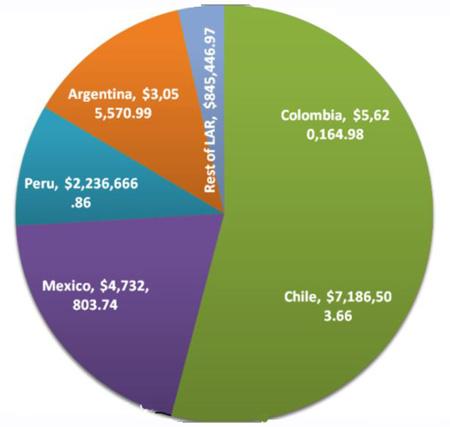However, in fairness to the region, the industry grew an average of 16.25% between year-end 2012 and year-end 2013 if one excludes the weight of Brazil in the performance of the leasing industry.
Alta LAR 100, the Alta Group’s annual report that ranks the 100 largest equipment leasing companies in Latin America, reveals that a key feature of the leasing industry is an increasing participation of operating lessors and renting companies in the rankings.
This, the Alta Group believes, is a good indication of the industry reaching maturity as it differentiates itself from other equipment financing alternatives, and indicates that business models are focusing ever more on asset/equipment management. Total estimated new business in Latin America in 2013 was valued at US$22.2 billion.
General performance of the leasing industry per country
| Country |
Sum |
Number |
Sum | Change |
Estimated |
|---|---|---|---|---|---|
| Colombia | $15,341,409.59 | 339 | $14,581,866.91 | 5.21% | $5,620,164.98 |
| Chile | $15,246,887.59 | 19 | $12,090,575.89 | 26.11% | $7,186,503.66 |
| Brazil | $12,438,601.62 | 55 | $20,840,961.59 | -40.32% | $(1,455,372.77) |
| Mexico | $10,269,470.38 | 84 | $8,304,999.96 | 23.65% | $4,732,803.74 |
| Peru | $8,094,368.28 | 17 | $8,786,552.14 | -7.88% | $2,236,666.86 |
| Argentina | $4,237,402.70 | 47 | $1,772,747.57 | 139.03% | $3,055,570.99 |
| Puerto Rico | $1,539,665.00 | 32 | $1,407,843.00 | 9.36% | $601,103.00 |
| Costa Rica | $424,106.00 | 5 | $364,001.00 | 16.51% | $181,438.67 |
| Venezuela | $232,121.85 | 16 | $329,324.71 | -29.52% | $12,572.04 |
| Bolivia | $69,034.03 | 3 | $51,536.56 | 33.95% | $34,676.32 |
| Ecuador | $56,597.88 | 10 | $61,411.40 | -7.84% | $15,656.94 |
| Grand Total | $67,949,664.92 | 627 | $68,591,820.74 | 0.94% | $22,221,784.42 |
While Brazil’s industry has continued its downward spiral, it is worthwhile to compare this with the phenomenal growth of equipment leasing in Argentina.
“The decline in Brazil,” the report states,“ is explained by the virtual paralysis of the banks’ business model for leasing, combined with the sluggish state of the economy. Still, the leasing industry enjoys a favorable legal and taxenvironment in regards to income tax, and uncertainty in regards to a municipal tax.”
It is the second tax (ISS or tax over services) that became the key deterrent to the growth of the leasing industry, a decision reflective of the poor risk management attitudes of the Brazilian financial system.
“The leasing industry in Brazil also exhibits lack of motivation to innovate or differentiate their offerings.”
Brazilian banks dominate
The dominant players ended up being the banks.
Lessors (such as the companies affiliated with Itau, the largest Brazilian bank) consolidated their market presence by acquiring the former auto financing captives of Fiat, Ford, and other companies. But their offerings were no different than massive full-payout leases, which are commodities. As a result of this commoditization, motor vehicle financing is being moved from the leasing units of banking groups into their credit arms. The banks are not losing the business. Lessors keep paying the tab.
Enthusiasm in Argentina
Argentina’s growth, by contrast, is the combination of very enthusiastic leadership in the leasing industry, with a favorable tax environment.
Despite the challenging events that led the government of Argentina to default, the private sector, and in particular the leasing industry, showed the importance of investing in capital goods. Gross capital formation grew over 23% year-to-year in Argentina and the leasing industry played an important role in the country.
Colombia the largest player
In the current Alta LAR 100 report, Colombia rises up the list to become the country hosting the largest leasing industry in Latin America.
What is the main reason for this?
Colombia was the only country that has complete information available, which enabled Alta to assemble data for all 339 companies involved in leasing, most of them in the business of operating leases. Despite this methodological warning, the clear conclusion is that the leasing industry in Colombia has emerged as a very innovative and growing market.
In fact, the largest leasing company in Latin America is, again, a Colombian lessor, namely Leasing Bancolombia.
Tax reforms make Chilean lessors cautious
Chile jumped to the second position due to phenomenal growth in the housing leasing market and impressive gains by individual companies such as Tanner. However, recent shifts in economic policy in Chile, including a recently enacted tax reform, lead Alta to be cautious about the Chilean leasing industry’s potential for future growth.
Mexico is experiencing interesting changes. Despite financial and tax reforms recently enacted that were expected to slow down the leasing industry, the country showed a 23.65% year-to-year growth reflective of a stronger investment in capital goods and new foreign investment coming into the industry. This is overshadowing the slow market exit of a number of players that cannot cope with new regulatory requirements and changes in tax rules.
Leasing portfolio values in Peru, Venezuela, and Ecuador decreased
Venezuela’s situation is the result of a very distressed economy. Peru’s decline was led by the reduction of mining sector output and investments, and a generalized slow-down of the economy.
Ecuador seems unconcerned about innovation in the leasing business since finance leases lost their tax advantage. Here, the absent elements that are needed for growth are innovation and leadership.
Bolivia, with only three leasing companies, showed important growth. This is a good indication about the quality of Bolivian leaders in the leasing industry.
Lack of transparency
Countries in Central America and the Caribbean are still reluctant to produce meaningful statistics about their size, volume, and performance.
Again, there are a few exceptions, notably Costa Rica, and these exceptions are becoming leaders in the sub region.
Figure 1 shows the calculation of new originations (under the column of “Volume”). These calculations are based upon experienced observation of equipment leasing companies’ portfolios, and in some limited cases, by direct reports from the companies. Therefore, as an estimate, it must be taken as an approximation but not as a representation of total accuracy.
How new volume was originated in the region

Active multi-national groups
Some of the multi-national groups active in Latin America are underestimated due to the fact that their data is not available in full.
GE Capital, IBM Global Financing, and Caterpillar Financial are the most remarkable examples of this. CSI did not supply data for many of the countries where it operates, in particular those in Central America. The aforementioned notwithstanding, it is clear that the “multilatinas” are still leading the industry, which means that the most active multinational groups are from within the region, namely Itau, Bancolombia, and GrupoAval.
In the case of Itau, the reduction of its size in Brazil was offset by the growth induced by the acquisition of Corpbanca, which led to consolidation of both groups.
The European groups show a mixed performance: Santander grew as well as BBVA but HSBC declined in the region. Canadian Scotiabank is showing consistent progress.
The presence of multinationals with US headquarters has declined dramatically. Perhaps the most outstanding downfall is the exit of CIT Group from the markets in Colombia, Chile, and Argentina, followed by its announced exit from Mexico and Brazil.
Another interesting feature is that four of the Alta LAR 100 are government owned. These are: Banco del Estado (Chile), Leasing Bancoldex (Colombia), Banco Nacion (Argentina), and Banco Provincia (Buenos Aires Province).
Additionally, an emerging development to note is the increased investment by Chinese companies through the acquisition of two banks that are part of the Alta LAR 100 ranking. These banks are the Industrial and Commercial Bank of China of Argentina (f.k.a. Standard Bank), ranked No.64, and the China Construction Bank, which acquired the Brazilian banking group BicBanco, whereby the leasing company is ranked as No.74.
The Alta LAR 100 ranking of the top-10 largest leasing companies in Latin America, corresponding to the year-end of 2013
|
RANK 2012 |
RANK 2013 |
Company | COUNTRY |
2013 |
2013 |
Chg % |
|---|---|---|---|---|---|---|
| 1 | 1 |
Leasing |
Colombia | 5,187,600.75 | 5,011,259.00 | 3.5% |
| 16 | 2 |
Banco |
Brazil | 3,611,956.39 | 1,281,039.46 | 182% |
| 26 | 3 |
Leasing |
Chile | 3,221,126.31 | 675,178 | 377.1% |
| 3 | 4 |
Banco |
Peru | 3,073,369.00 | 3,468,106.77 | -11.4% |
| 5 | 5 |
Banco |
Chile | 2,566,133.96 | 2,677,571 | -4.2% |
| 6 | 6 |
Banco |
Colombia | 2,499,751.62 | 2,609,979.88 | -4.2% |
| 7 | 7 |
Banco |
Chile | 2,299,852.32 | 2,326,541 | -1.1% |
| 4 | 8 |
Bradesco |
Brazil | 2,229,157.12 | 3,077,718.93 | -27.6% |
| 24 | 9 | Corpbanca | Chile | 2,130,574.41 | 715,006 | 198.0% |
| 13 | 10 |
Davivienda |
Colombia | 1,930,961.80 | 1,410,058.17 | 36.9% |
A large number of operating leasing and renting companies are now populating the list, evidence of the move of the Latin American market away from the pure full-payout business model to an asset-based financing business model.
Some other observations are highlighted in the full report that are available for sale at www.thealtaconferencias.com .








